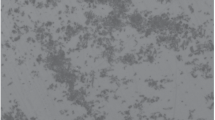Abstract
The choice of the composition of the components of a composite material that determines its prospects and demand has been substantiated. Liquid-phase combination is used to fabricate billets of an aluminum-matrix composite material of a new composition. The technological problems of introducing discrete Al2O3 nanofibers into an aluminum matrix are solved. A copper powder is used to overcome surface tension forces and to ensure a uniform reinforcing component distribution. When the components of the composite material are prepared, the reinforcing phase consisting of a transport powder and nanofibers is ground and the resulting conglomerate is introduced into a melt to form a composite material. The hardness of the reinforced specimens is higher than the hardness of the matrix, and sufficient uniformity of the hardness distribution over the cross section demonstrates the uniformity of introduced component distribution. An analysis of the fracture of specimens demonstrates a clear predominance of plastic deformation for the initial matrix alloy and an embrittlement effect in the case of reinforcement. Structural studies on a macrolevel show the signs characteristic of brittle fracture, and scanning electron microscopy (Tescan Vega IILMH microscope) studies demonstrate signs of ductile fracture. The fabrication of high-quality specimens and the results of studying the structure and properties confirm the efficiency of the technology developed for the introduction of fillers.




Similar content being viewed by others
REFERENCES
Yu. A. Kurganova, T. A. Chernyshova, L. I. Kobeleva, and S. V. Kurganov, “Service properties of aluminum-matrix precipitation-hardened composite materials and the prospects of their use on the modern structural material market,” Russ. Metall. (Metally), No. 7, 663–666 (2011). https://doi.org/10.1134/s003602951107010x
G. A. Kosnikov, “Liquid phase production technologies of alumomatrix nanocomposite billets (review),” J. Sib. Fed. Univ. Eng. Techn., No. 7, 409–415 (2014).
A. D. Romanov, E. A. Chernyshov, V. V. Myl’nikov, and E.A. Romanova, “Development of a technology for forming an aluminum-based composite material,” Mezhd. Zh. Prikl. Fund. Issled., No. 12–2, 176–179 (2014).
B. N. Sarada, M. P. L. Srinivasa, and G. Ugrasen, “Hardness and wear characteristics of hybrid aluminium metal matrix composites produced by stir casting technique,” Mater. Today: Proc., No. 2, 2878–2885 (2015). https://doi.org/10.1016/j.matpr.2015.07.305
A. J. Knowles, X. Jiang, M. Galano, and F. Audebert, “Microstructure and mechanical properties of 6061 Al alloy based composites with SiC nanoparticles,” J. Alloys Compd., No. 615, 401–405 (2014). https://doi.org/10.1016/j.jallcom.2014.01.134
X. Yao, Y. F. Zheng, and J. M. Liang, “Microstructures and tensile mechanical properties of an ultrafine grained AA6063–5 vol % SiC metal matrix nanocomposite synthesized by powder metallurgy,” Mater. Sci. Eng., A, No. 648, 225–234 (2015). https://doi.org/10.1016/j.msea.2015.09.059
P. B. Li, T. J. Chen, and H. Qin, “Effects of mold temperature on the microstructure and tensile properties of SiCp/2024 Al-based composites fabricated via powder thixoforming,” Mater. Design., No. 112, 34–45 (2016). https://doi.org/10.1016/j.matdes.2016.09.049
V. V. Berezovskii, Y. O. Solyaev, S. A. Lur’e, A. V. Babai-tsev, A. A. Shavnev, and Y. A. Kurganova, “Mechanical properties of a metallic composite material based on an aluminum alloy reinforced by dispersed silicon carbide particles,” Russ. Metall. (Metally), No. 10, 790–794 (2015). https://doi.org/10.1134/S0036029515100055
Y. Hu, Q. Ouyang, L. Yao, S. Chen, and L. Zhang, “A study of interparticulate strain in a hot-extruded SiCp/2014 Al composite,” Int. J. Miner. Metall. Mater., No. 26 (4), 523–529 (2019). https://doi.org/10.1007/s12613-019-1760-6
S. C. Tjong, “Recent progress in the development and properties of novel metal matrix nanocomposites reinforced with carbon nanotubes and graphene nanosheets,” Mater. Sci. Eng., R 74 (10), 281–350 (2013). https://doi.org/10.1016/j.mser.2013.08.001
S. Li, Y. Su, X. Zhu, H. Jin, Q. Ouyang, and D. Zhang, “Enhanced mechanical behavior and fabrication of silicon carbide particles covered by in-situ carbon nanotube reinforced 6061 aluminum matrix composites,” Mater. Design., No. 107. P. 130–138 (2016). https://doi.org/10.1016/j.matdes.2016.06.021
R. Harichandran and N. Selvakumar, “Effect of nano/micro B4C particles on the mechanical properties of aluminium metal matrix composites fabricated by ultrasonic cavitation-assisted solidification process,” Archives of Civil and Mech. Eng. 16 (1), 147–158 (2016). https://doi.org/10.1016/j.acme.2015.07.001
Yu. A. Kurganova and S. P. Scherbakov, “Influence of a discrete additive of aluminum oxide on structure and properties of aluminum alloy,” J. Mining Inst., No. 228, 717–721 (2017). https://doi.org/10.25515/pmi.2017.6.717
A. Mazahery, H. Abdizadeh, and H. R. Baharvandi, “Development of high-performance A356/nano-Al2O3 composites,” Mater. Sci. Eng., A, No. 518, 61–64 (2009). https://doi.org/10.1016/j.msea.2009.04.014
I. El-Mahallawi, H. Abdelkader, L. Yousef, A. Amerc, J. Mayerd, and A. Schwedtd, “Influence of Al2O3 nano-dispersions on microstructure features and mechanical properties of cast and T6 heat-treated Al Si hypoeutectic alloys,” Mater. Sci. Eng., A, No. 556, 76–87 (2012). https://doi.org/10.1016/j.msea.2012.06.061
Y. C. Kang and S. L. I. Chan, “Tensile properties of nanometric Al2O3 particulate-reinforced aluminum matrix composites,” Mater. Chem. Phys., No. 85, 438–443 (2004). https://doi.org/10.1016/j.matchemphys.2004.02.002
Yu. A. Lopatina, Yu. A. Kurganova, and V. K. Gaaze, “Installation for mixing particles into a metal matrix melt,” RF Patent 179266, Byull. Izobret., No. 13 (2018).
S. Pourhosseini, H. Beygi, and S. A. Sajjadi, “Effect of metal coating of reinforcements on the microstructure and mechanical properties of Al–Al2O3 nanocomposites,” Mater. Sci. Techn. 34 (2), 145–152 (2018). https://doi.org/10.1080/02670836.2017.1366708
C. A. Leon, G. Mendoza-Suarez, and R. A. L. Drew, “Wettability and spreading kinetics of molten aluminum on copper-coated ceramics,” J. Mater. Sci., No. 41, 5081–5087 (2006). https://doi.org/10.1007/s10853-006-0443-7
V. M. Serpova, A. A. Shavnev, O. I. Grishina, E. I. Krasnov, and Yu. O. Solyaev, “Wettability and interfacial interaction in MCM based on an aluminum matrix reinforced with Al2O3,” Materialoved., No. 12, 29–35 (2014).
Author information
Authors and Affiliations
Corresponding author
Additional information
Translated by K. Shakhlevich
Rights and permissions
About this article
Cite this article
Kurganova, Y.A., Shcherbakov, S.P., Chen’, I. et al. Technology for Producing a Promising Aluminum-Matrix Composite Material with Discrete Al2O3 Fibers. Russ. Metall. 2020, 1531–1536 (2020). https://doi.org/10.1134/S0036029520130194
Received:
Revised:
Accepted:
Published:
Issue Date:
DOI: https://doi.org/10.1134/S0036029520130194




